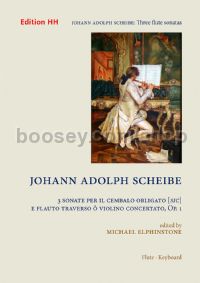Three Sonatas Op.1 (Flute & Piano)
Three Sonatas Op.1 (Flute & Piano)
* Estimated price converted from UK retail price
Scheibe’s three sonatas for flute (or violin) and obbligato harpsichord were published by Haffner in the late 1750’s, but were probably composed much earlier; they contain a significant quantity of elaborate imitative writing that is out of character with Scheibe’s later music. Although rooted in the same tradition as the sonatas for flute and obbligato harpsichord by J.S. Bach, C.P.E Bach, and composers at Berlin court of Frederick the Great, these are more substantial works, each having four movements in the traditional slow-fast-slow-fast scheme. For the most part they are trio sonatas, the right hand of the harpsichord acting as the second treble voice, but several movements feature idiomatic writing for the keyboard. Also interesting is the large amount of ornamentation called for, particularly in the harpsichord part. While Scheibe disapproved of the excessive embellishments that Bach actually wrote into his melody lines, these sonatas are nonetheless heavily ornamented, albeit through the insertion of notational symbols; in addition to turns and mordents, Scheibe uses no less than three different trill symbols!




